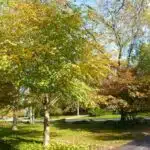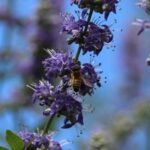Choosing the best tree for a garden or yard is like trying to find the perfect fit for a tailored suit. You want something that is attractive, fast-growing and will bring a sense of order and beauty to your space. Fortunately, there are many types of trees that fit this bill and finding the right one doesn’t have to be an arduous task.
The 15 best fast-growing trees featured in this article will help you get the most out of your gardening experience, quickly. From trees with lush foliage to those with vibrant flowers, all these species are ideal for adding color, texture and structure to any landscape.
For professionals in botany and gardening, selecting the right tree that balances aesthetics with practicality is key for creating beautiful outdoor spaces that last for years to come. This article provides an overview of some of the most popular fast-growing trees available today so you can make an informed decision about which one is best for you.
Silver Maple
Silver maple is an excellent choice for any gardener looking for a fast-growing tree. It typically grows to a height of 50 feet, with a trunk diameter of up to 24 inches. This deciduous tree thrives when planted in moist, well-drained soil and can even tolerate dry conditions or occasional flooding. Plus, its beautiful silver-gray bark makes it an attractive addition to any landscape.
In terms of growth rate, the silver maple is one of the fastest growing trees available. It can easily add up to three feet per year if given enough sunlight and moisture. During the summer months, this tree produces lovely green leaves that turn yellow in autumn and provide a stunning display before they fall off in winter. The silver maple also produces winged seeds called samaras that attract birds and other wildlife throughout the year.
This species is incredibly resilient and can survive in a wide range of climates, making it ideal for gardeners in temperate zones who want a quick-growing tree without taking on too much risk. With proper maintenance and care, you’ll be able to enjoy the beauty of this versatile species for many years to come!
The quaking aspen is another great option for those looking for a fast-growing tree…
Quaking Aspen
As the saying goes, “the early bird catches the worm”; planting fast-growing trees is one way to reap the rewards of gardening quickly. Quaking aspen (Populus tremuloides) is a popular choice for homeowners who want a fast-growing tree that can provide shade and beauty in a relatively short period of time. This species is an excellent choice for those looking to add a majestic, long-lasting tree to their landscape.
This deciduous tree can reach heights of up to 80 feet with a trunk diameter of 2-4 feet, making it an impressive addition to any garden. The quaking aspen has attractive foliage that turns yellow in autumn and drops its leaves in winter, revealing its attractive bark with age. It’s also quite tolerant of various soil types and climates, making it suitable for diverse environments.
In terms of upkeep, quaking aspens need very little maintenance and are generally disease and pest resistant. They prefer moist soils but can handle some drought conditions if well established. When planting this species, it’s important to space them at least 20 feet apart so they have room to grow without competing with each other for resources. Additionally: •tFor best results: otProvide adequate water during establishment otFertilize annually •tTo ensure longevity: otPrune or thin branches regularly otKeep an eye out for disease or insects
Quaking aspen is an excellent option for those looking to add color and texture to their landscapes while enjoying the benefits of having a fast-growing tree on their property. With proper care and maintenance, this species can be enjoyed for many years – making it one of the best choices when selecting fast-growing trees.
Eastern White Pine
The Eastern White Pine is a botanical wonder. It is fast-growing, hardy, and aesthetically pleasing – a trifecta of qualities for any gardener to cherish. This tree can grow up to 3 feet per year and reach heights of over 100 feet. Its majestic stature has made it a favorite among landscapers and homeowners alike. Here are five reasons why the Eastern White Pine is an ideal addition to your garden:
- The evergreen foliage provides year-round beauty and privacy.
- It grows quickly, adding lushness in no time at all.
- The needles are soft and fragrant, providing an ambiance of relaxation when sitting or walking nearby.
- The tree’s sturdy branches make it perfect for hanging birdhouses or other decorations that will bring joy to viewers below.
- The wood is lightweight but strong, making it suitable for construction projects such as fencing and decks as well as furniture-building endeavors.
No matter what your gardening needs may be, the Eastern White Pine should be high on your list of trees to consider. Not only is it easy to care for, but its fast growth rate means you won’t have to wait years before seeing results in your yard or garden space – something that can be invaluable when trying to meet deadlines for landscaping projects or when wanting to add aesthetic value quickly before the next holiday season arrives! With its many benefits, there’s no denying that the Eastern White Pine is a great choice when needing a fast-growing tree with multiple uses in mind.
Leyland Cypress
The fourth fast-growing tree that we’ll discuss is the Leyland cypress. This tree is an evergreen with a conical shape and deep green needle-like foliage. It’s an incredibly fast-growing species, reaching up to three feet per year, and can grow up to 50 feet tall and 20-30 feet wide in its mature form. It’s also quite versatile, tolerating a wide range of soil types and climates, making it suitable for many different locations.
This particular tree has several benefits as well. It provides excellent shelter and privacy, due to its dense foliage and height capabilities. Plus, it’s easy to maintain and generally disease-free, requiring only minimal pruning which makes it perfect for those who don’t have much experience with gardening. And because of its rapid growth rate, you won’t have to wait long for the tree to reach maturity – in just a few years you can expect your Leyland cypress to be towering above your backyard!
Finally, this species is not only attractive but also fairly hardy – so it’s likely to stick around for a good while if you take proper care of it. With all these features combined, the Leyland cypress is an ideal choice for anyone looking for a fast-growing tree that provides plenty of shade and privacy while still being relatively low maintenance.
Willow Hybrid
The fifth of the fast-growing trees on our list is the willow hybrid. This unique species of tree has been bred for its rapid growth, making it popular with those looking to enjoy a mature tree in a short period of time. It’s also an attractive option due to its spreading growth habit and cascading branches, providing a natural privacy screen when planted in a row.
When planting willow hybrids, one must take care to provide enough space for their rapidly expanding root structure; otherwise, they can become invasive and can damage foundations or other structures nearby. Additionally, these trees require frequent pruning to maintain their shape and size. However, with proper care and maintenance, these trees can be enjoyed for many years.
The willow hybrid is an excellent choice for those seeking a fast-growing tree that provides visual appeal as well as privacy screening. With the right amount of love and attention, this hardy tree will thrive in many different environments while making any space more beautiful. And now let’s move onto the next fast-growing tree on our list: the tuliptree.
Tuliptree
The tuliptree is a majestic force of nature, reaching up to the sky like an ancient sentinel. It symbolizes strength, resilience, and stability – qualities that are essential for any garden or landscape. In many ways, the tuliptree is a perfect representation of growth and progress.
When it comes to fast-growing trees, the tuliptree stands out for its impressive rate of growth. It can reach heights of up to 90 feet in just 15 years! It’s also a very hardy tree, making it an ideal choice for areas with extreme temperatures and weather conditions. Here are some key qualities that make the tuliptree an excellent choice:
• Quick Growth: The tuliptree is known to be one of the fastest-growing trees available, with some specimens reaching their mature height in as little as 15 years.
• Versatility: The tree is capable of growing in a variety of climates and soil types, making it suitable for almost any kind of landscape.
• Low Maintenance: This tree requires very little maintenance once established, making it an ideal choice for busy homeowners who don’t have much time to devote to gardening or landscaping.
Given its impressive growth rate and hardiness, it’s no surprise that the tuliptree has become a popular choice among those looking for a fast-growing option in their garden or landscape project. Not only does it provide quick results but it also adds a touch of sophistication and beauty to any setting – something that few other trees can offer. With proper care and attention, this majestic tree will continue to be an asset to your outdoor space for years to come.
Thornless Honeylocust
The seventh fast-growing tree is the thornless honeylocust. This resilient species of tree shoots up with astonishing speed, much like a rocket soaring to the sky. As soon as it’s planted, its roots reach out into the soil and quickly latch onto essential nutrients and moisture, enabling this tree to ascend to majestic heights in no time at all.
This tree has been used for centuries by gardeners and landscapers alike due to its impressive growth rate. Despite being known as a ‘thornless’ honeylocust, be aware that small thorns may still appear on some specimens of this species. Nonetheless, they remain far less dangerous than other varieties of honeylocusts which possess more substantial thorns.
The honeylocust stands as a testament to nature’s power when it comes to growing trees quickly. Its ability to sprout and stretch towards the heavens can transform any garden or landscape in mere months if implemented correctly. It’s an amazing sight to behold when these trees reach their full height; gazing up at the towering canopy of leaves is nothing short of breathtaking! Transitioning seamlessly into the next topic, let us now take a look at the red maple…
Red Maple
The red maple stands tall and proud, with its leaves like a curtain of flame. As if rising from the Earth’s surface, it is sure to add a dramatic flair to any garden. The red maple is a popular fast-growing tree for the home garden, widely adapted to many soil types and climates across North America.
This tree grows quickly in full sun or part shade and can reach heights up to 40 feet tall in just 15 years. It tolerates wet soils better than most trees, as well as some short-term flooding. Red maple also has an attractive fall foliage color, ranging from yellow to orange-red.
The red maple is an excellent specimen tree because of its wide range of sizes, shapes and colors. Its attractive bark is smooth on young trees but will become more shaggy over time. Pruning should be kept to a minimum; this species will naturally form its own shape without much help from you!
In addition to its beauty, the red maple is also quite versatile when it comes to uses in landscaping or around the home. It can be used as a screen or windbreak and provides good shade cover for smaller plants underneath it. It can also act as a specimen piece for lawns or gardens, adding height and interest with its vibrant fall foliage color.
Chinese Pistache
The Chinese Pistache, a graceful and regal tree, is the perfect symbol of strength and growth. It stands tall in its beauty with an impressive rate of growth that offers much to admire. With its bright green leaves, deep red fall foliage, and smooth bark it makes for a stunning addition to any garden. Here are 3 reasons why this tree is ideal for anyone looking to bring some life into their landscape:
Fast-growing: The Chinese Pistache has an astonishing growth rate of up to 4 feet per year and can reach heights of up to 35 feet when fully mature. This makes it an excellent choice for those looking for a fast-growing tree with beautiful fall coloration.
Hardy: Chinese Pistache is incredibly resistant to drought, heat, pests, and disease which makes it an excellent choice for many climates. It can also withstand temperatures as low as -10 degrees Fahrenheit without any damage or injury.
Adaptable: Chinese Pistache is highly adaptable and can thrive in almost any soil type including clay and sandy soils with proper irrigation. It also does well in full sun or partial shade making it a great choice for those looking to plant trees in less than ideal conditions.
The Chinese Pistache is truly one of nature’s most remarkable specimens and deserves a place in any gardeners heart. With its fast-growth rate, hardiness, and adaptability this tree can bring joy and color into any landscape while still being easy to maintain. Whether you’re looking to add some fall foliage or just some extra greenery the Chinese Pistache is the perfect companion for any garden enthusiast!
Black Cherry
The black cherry tree is like a sentinel, standing tall and proud against the elements. It’s an impressive sight to behold, one that will leave an impression on anyone fortunate enough to witness its magnificence. With its deep red bark and its lush foliage, it’s a great choice for any gardener looking to add some exotic flair to their garden.
The black cherry tree grows quickly and can reach heights of up to 50 feet or more. Its hardy nature makes it perfect for all climates, from hot summers in the south to cold winters in the north. Plus, its long lifespan means you’ll be able to enjoy its beauty for years on end. In terms of maintenance, it requires minimal effort but may need pruning if it starts growing out of bounds.
Since the black cherry tree is relatively pest-resistant and drought-tolerant once established, it’s a great choice for those who don’t have time or energy for regular maintenance. Whether you’re looking for a statement piece or something that blends in with your existing landscape, this is one tree that won’t disappoint. With its graceful beauty and ability to thrive in various conditions, the black cherry tree is sure to give your garden an extra touch of elegance and charm!
And while we’ve enjoyed discussing the attributes of the black cherry tree so far, let us now move onto the next featured species – the dawn redwood…
Dawn Redwood
The dawn redwood is truly a marvel of nature that can almost appear to defy the laws of botany. While its name suggests an association with the dawn of time, this tree is actually one of the fastest-growing trees in existence today. Growing as much as 10 feet per year, it can reach heights of up to 100 feet in just 20 years! Despite its fast growth, however, this tree has a surprisingly delicate nature and requires special care when grown in urban or suburban environments.
This majestic species has many features that make it ideal for planting near homes or businesses. It’s highly tolerant of both cold and warm temperatures, making it a great choice for landscaping in different climates. Additionally, its deep root system makes it drought resistant and helps prevent soil erosion due to wind or rain. Finally, its dense needles provide excellent shade for gardens and other outdoor areas throughout the year.
Given all these benefits and its fast growth rate, it’s no surprise that the dawn redwood is quickly becoming one of the most popular trees for landscapers looking to add some beauty to their property. With its breathtaking form and lush foliage, this species is sure to be a stunning addition to any garden or landscape!
Green Giant Arborvitae
The dawn redwood is a fast-growing tree, but it’s not the only one. The green giant arborvitae is another strong candidate. Its growth rate is remarkable, and its height and spread make it an attractive addition to any landscaping project.
Unlike the dawn redwood, the green giant arborvitae can reach heights of up to 70 feet with a width of 15 to 20 feet. It grows best in full sun or partial shade and is tolerant of both dry and wet soils. This makes it an ideal choice for homeowners looking for a tall evergreen that can handle various weather conditions.
The green giant arborvitae has been a popular choice in recent years due to its ability to grow quickly, providing a lush backdrop for gardens or yards in no time at all. Because of its dense foliage, it’s also great for providing privacy from neighbors or noisy streets. In addition, its vibrant evergreen color provides year-round interest that won’t fade away over time like some other trees might.
Next up: The bald cypress — another fast-growing tree with plenty of potential!
Bald Cypress
The majestic bald cypress is a sight to behold. Its lush, evergreen foliage and stout trunk make it a perfect addition to any garden. Not only does this tree look great, but it’s also one of the fastest-growing trees available:
- It can grow up to two feet per year;
- It’s extremely tolerant of wet conditions, making it ideal for areas prone to flooding;
- It requires very little maintenance once established;
- And it provides excellent wildlife habitat.
As a botanist, I’m always impressed with the bald cypress’ hardiness and fast growth rate. This tree is an excellent choice for anyone looking for a beautiful and low maintenance specimen. Best of all, its dense canopy provides invaluable shade and shelter for birds and other wildlife.
The bald cypress is certainly one of the most impressive fast-growing trees out there. Its versatility and beauty make it an ideal choice for any gardener or landscaper looking to add some greenery to their yard. With its reliable growth rate, this tree can quickly become the centerpiece of your garden in no time at all – transitioning effortlessly into the next section about American sweetgum!
American Sweetgum
The American sweetgum, or Liquidambar styraciflua, is a popular fast-growing tree for gardeners. Not only does it look great, but its hardiness makes it an ideal choice for any area. It grows quickly and produces a beautiful canopy of leaves that can provide shade and shelter from the sun. Additionally, this species is tolerant of most soil types, making it suitable for many different gardening environments.
The American sweetgum is also known for its impressive autumn show. Its leaves turn vibrant shades of yellow, red and purple as the season progresses and this makes for an eye-catching display in any garden. For people looking to add some seasonal interest to their landscape, this species is an excellent choice.
Moreover, the American sweetgum has been used medicinally throughout history. Its sap was believed to have healing properties and was used to treat various ailments including colds and fevers. This tree also has many uses in craftsmanship such as making furniture or creating traditional drums out of its wood.
Given these qualities, the American sweetgum is a great addition to any garden or landscape where there’s a need for a fast-growing tree with attractive foliage that provides autumn color and medicinal benefits. Moving on from here we come to the eastern redbud…
Eastern Redbud
The Eastern Redbud is a stunning sight, with its deep pink-purple blooms that seem to burst forth from the buds in the springtime. It’s like watching a fireworks show for trees! When planted, it quickly grows into an attractive, rounded shape with dense foliage. The lovely foliage is composed of heart-shaped leaves that are glossy green in summer and change to yellow and purple in fall.
This native North American tree is both fast-growing and long-lived. It can reach heights of up to 30 feet tall and spread as wide as 25 feet. Here are some benefits to planting an Eastern Redbud:
- Produces lovely flowers in spring
- Attractive heart-shaped leaves
- Provides shade and privacy
- Fast-growing
- Long-lived
The Eastern Redbud is a great choice for gardeners who want a fast-growing tree for their landscape. It’s easy to care for and offers a range of benefits that make it ideal for any garden or yard, from providing shade and privacy to adding beauty with its colorful blooms and vivid foliage. With its hardy nature, this tree can provide years of enjoyment when planted in the right conditions.
Frequently Asked Questions
What Are The Best Soil And Light Conditions For These Trees?
When planting fast-growing trees, it is important to consider the soil and light conditions in order to achieve optimal results. In terms of soil, well-draining, loamy soils are ideal for most species. Additionally, a pH level between 5.5 and 7.0 will ensure that nutrients are available for the tree’s growth.
Light also plays an essential role in providing a suitable environment for your tree’s growth. The amount of light required varies depending on the species – some trees require full sun exposure while others prefer partial shade or dappled sunlight. It’s important to know what your specific tree needs before planting so you can provide the best possible conditions for its growth.
Furthermore, you should be aware of any other factors that could affect your tree’s health and success: • Temperature – Some species may need protection from extreme temperatures or frost; • Water – Many fast-growing trees require consistent watering to thrive; • Pests – Be aware of potential pests that could damage your tree’s health; • Wind – Make sure you have adequate shelter from strong winds which can damage branches and foliage.
As a specialist in botany and gardening, I would advise doing thorough research on each individual species before planting so that you can provide the best environment for them to grow quickly and flourish over time. By understanding each species’ particular requirements for soil, light, temperature, water and pest control, you can ensure their success as well as helping others achieve their goal of planting fast-growing trees that will bring beauty and life into their gardens.
How Long Will It Take For These Trees To Reach Full Maturity?
When it comes to fast-growing trees, the rate of growth can be quite astonishing. According to statistics, some trees can grow up to 3 feet per year! But this speedy growth also often means that these trees don’t live for very long either. So how long does it take for these trees to reach full maturity?
The answer depends on the species of tree and the conditions in which it is grown. On average, most fast-growing trees will take four to six years before they reach maturity. However, there are a few exceptions – some varieties may take up to ten years or more.
For best results, fast-growing trees should be planted in fertile soil with plenty of moisture and sunlight. The right soil conditions can make all the difference when it comes to how quickly a tree grows and how long it lives. Applying regular fertilizers can also help speed up the process by providing additional nutrients to boost growth. Additionally, pruning and trimming back branches at regular intervals helps direct energy towards healthy development rather than excessive foliage production.
With proper care and maintenance, fast-growing trees can reach their full potential quickly and provide many years of enjoyment for gardeners and nature lovers alike. By choosing a species that suits your needs, you can ensure that your tree will thrive for many more seasons to come!
Are These Trees Suitable For Areas With High Winds?
Wind resistance is an important consideration when selecting trees for your garden, as strong winds can cause damage to the tree’s branches and roots. When choosing fast-growing trees, it’s important to research the species’ wind resistance. The good news is that many of the fast-growing trees recommended by The Spruce have excellent wind resistance.
For instance, Lombardy poplars are known for their rapid growth and their ability to withstand high winds. Other popular fast-growing trees such as silver maple, hybrid poplar, and willow are also highly resistant to wind damage. As they grow quickly, they may not be able to provide adequate protection against extreme weather conditions.
On the other hand, some slower-growing trees such as Douglas fir and Eastern Redbud have more sturdy root systems that help them better withstand high winds. If you live in an area with strong winds, you may want to choose these types of trees over faster-growing varieties for greater protection against stormy conditions.
TIP: Before planting a tree in an area prone to high winds, make sure you understand the species’ characteristics and wind resistance level so you can select the most suitable option for your garden!
How Often Should These Trees Be Watered?
Watering a tree is like giving it a drink of life. It’s essential for its growth and health, especially with fast-growing trees. As a specialist in botany and gardening, I’m here to help you understand how often these trees should be watered.
First, the frequency of watering depends on several factors such as soil texture, climate and season. If you live in an area with high winds that blow away the moisture from the soil quickly, you may need to water more frequently than if you lived in a humid climate. For example, young trees must be watered more often than older ones since their roots are not yet established enough to reach deeper into the ground.
Second, fast-growing trees require more water throughout the year compared to slower growing varieties. Therefore, they need to be watered at least once or twice per week during warm months and once every two weeks during cooler seasons. To ensure that your tree gets enough water, use a soaker hose or drip irrigation system near its base; this will make sure that there is no runoff or evaporation of water due to windy conditions.
Finally, pay close attention to your tree’s leaves; if they start wilting or turning yellow then it might be time for another watering session! You can also check the soil moisture by sticking your finger in it – if it feels dry up to one inch deep then it’s time to give your tree some love in the form of water!
What Kind Of Pruning Is Necessary To Maintain These Trees?
Pruning is an important part of keeping fast-growing trees healthy and vibrant. It allows for better air circulation, helps to maintain shape, size, and aesthetics, and can even be used to direct growth. Depending on the species of tree, pruning can be done at any time during the year but should generally be done between late winter and early spring when the tree is in its dormant state.
When it comes to pruning fast-growing trees, there are several techniques that one should consider. For example, if you want to properly train a young tree or shrub into a desired shape or size, then heading or shearing may be necessary. Heading involves cutting branches back to a lateral branch while shearing involves cutting off entire branches with hedge clippers at an angle or flat across so that new growth appears uniform. Additionally, thinning out dense areas can help promote air flow and reduce disease risk by allowing more light penetration into the interior canopy of the tree.
The most important point to remember when it comes to pruning fast-growing trees is that less is more. When making cuts, always use sharp tools and make sure they are clean in order to prevent diseases from spreading throughout your landscape. Also keep in mind that any major pruning should only occur after flowering as this will help ensure a good display of flowers next season. Taking these steps will help you maintain your fast-growing trees for many years to come.
Conclusion
When it comes to choosing a fast-growing tree for your garden or yard, it is important to understand the needs and requirements of each species. The 15 best fast-growing trees selected in this article are all suitable for a range of soil types, light conditions and climates. It is important to provide adequate water and pruning to ensure that these trees reach their full potential.
The symbolism of trees can be seen throughout history, from the Tree of Knowledge in the Bible to the symbolic representation of life in many cultures. Trees represent strength, stability, growth and renewal; they are symbols of hope and new beginnings. A fast-growing tree can provide all these things – both literally and symbolically – in your garden or yard.
In conclusion, when selecting a tree for your garden or yard, it is important to consider the soil type, light conditions, climate and pruning requirements; as well as its symbolism. All 15 of the best fast-growing trees outlined in this article will provide you with an abundance of shade, beauty and symbolism. As a specialist in botany and gardening, I highly recommend any one of these varieties for your outdoor space.





























